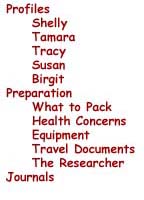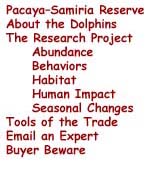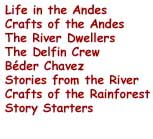|
|

|
|
| |
Last year as we were getting ready for our first trip we kept
a jounal of things we were doing to prepare.
|
|
|
|
|
|
|
|
|
| April
2, 1999 Shelly's Journal |
|
|
Yahoo!!! LandSea
Systems is going to lend us a satellite phone so that we can send
data back to our website while we are on the expedition. I am so
excited. I think this is really going to happen. |
|


|
|
|
| May
13, 1999 Susan's Journal |
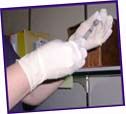
|
|
Today I spent the
day trying to find an insurance company that will insure our satellite
phone in case something happens to it while we are in Peru. I am
a little frustrated about that but I am very pleased with how hard
everyone is working to get our website ready before we go.
I do need to start planning when I am going
to get the rest of my vaccinations. Fortunately, I got my Tetanus
and Diphtheria vaccinations last year. This really reminds me
of the Peace Corps. Wow, did I ever have to get a lot of shots
to go to Botswana.
|
|


|
|
|
| May
20, 1999 Tracy's Journal |

|
|
This afternoon I
visited the office of the Peruvian Counselor General. His office
is in a tall office building in downtown San Francisco. My "mission"
was to get special "business" visas affixed to each of Shelly's,
Susan's and my passports.
Because we will be carrying so much equipment
into Peru, we were advised that these special visas would help
custom officials know that we need our equipment for our trip
and that we aren't going to sell it. (Almost all countries have
strict laws about the importing and reselling of goods.)
While one of the aides took care of our
visas, I looked around the waiting room. There were lots of posters
and cards in written in Spanish. The posters invited people to
come to special Peruvian celebrations and parties, which were
being held around the San Francisco area. (When I lived in Australia,
I remember how much I enjoyed having other Americans with whom
I could celebrate Thanksgiving and the Fourth of July. I guess
that these parties would make Peruvians living here less homesick,
too.)
The waiting room also had lots of maps
of Peru on the wall. Looking at the maps helped me to better understand
where we are going once we're on the boat. Also, I didn't realize
how far back the source of the Amazon River went into Peru!
Before I left, I spoke with a man in charge
of commerce who will also help us get permission to bring our
equipment in and out of Peru. The process will probably take another
few weeks. I'll have to wait for a phone call or fax to know if
I have to go back to the consulate and fill out more forms.
By the way -- I love the colorful stamps
which they consulate placed in my passport!
|
|


|
|
|
| June
1, 1999 Shelly's Journal |
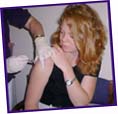
|
|
Shots! Ouch!
Today I finally got the shots and all the
other medical stuff taken care of at Kaiser. First I had to do
my research with the Center for Disease Control. They suggested
that I get Malaria pills and shots for Tetanus, Rabies, Hepatitis
A, and Cholera. I found out the vaccine for Cholera is not very
effective, so my doctor doesn't even give it to people. When I
called Kaiser, they were very helpful. There is a nurse whose
job it is to give all the travelers vaccinations. She told me
to come anytime before the trip. The nurse told me that I did
not need a rabies shot since I was going to be in Peru such a
short time. I guess the effects take long enough that I will be
back in the States if a rabid animal does bite me. I sure hope
that doesn't happen! The one other thing that the nurse suggested
I get was the oral polio vaccine. When I was a kid the vaccine
had to be scraped into the upper arm and left a scar. This new
type was much easier. I just have to remember to take the Malaria
pills before I go, while I am there, and when I get back. Send
me an email reminder if you think about it.
|
|
 |
|
|
| June
7, 1999 Tracy's Journal |
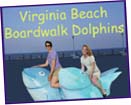
|
|
Shelly and I spent the morning at LandSea
Systems in Virginia Beach, Virginia. LandSea is the company which
markets and trains folks in how to use satellite phones.
Using the actual Immarsat M satellite phone which we will be
using from the shores of the Amazon River, Kevin taught us how
to make a very long distance phone call.
The sat phone (as they call it) works like this: We use the handset
(which looks like the "walkaround" phone like I have at home)
to dial the phone number to our Internet Service Provider (SlipNet)
in California. Since we won't have a phone line in the Amazon,
the Immarsat's antenna sends a microwave signal to a satellite
in space. The satellite contacts its company in North America
which will route the "call" through telephone lines. Using a computer
attached to the Immarsat, we can then send e-mail, text and pictures
to our website. I drew a picture of this to help explain it to
Susan.
Although this may sound a little bit complicated, it really works
a lot like a making any international phone call.
Barbara (the president of LandSea), Leslie (who has been walking
us through all the red tape &endash; and got us a neat hotel
room RIGHT ON THE BEACH), Kevin (our trainer) and all the other
folks at LandSea were wonderful to us. We are sooooo grateful
to them for loaning this piece of equipment and helping us to
make our dream come true.
Enough of this techie stuff. Shelly and I are going downstairs
to spend the afternoon at the beach.
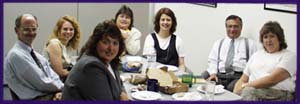
|
|
|
|
|
| June
24, 1999 Tracy's Journal |

|
|
Today we met at Susan's house to check
out all of our computer equipment. When you're on the Amazon River,
you can't just run out and get something that you realize you forgot.
We realized that we should bring a couple of extra power strips
so that we could recharge EVERYTHING when the boat has its generator
on.
Using the minihub that Farallon has given us, we hooked up our
two Mac G3 Powerbooks to Shelly's PC laptop. Now we can share
information and pictures with each other. This is important, as
for the most part, Susan and I will be adjusting the pictures
on our Macs before we send them to the Internet. Shelly, on the
other hand, will actually send the images via her PC on the Immarsat
phone.
Susan's living room is totally demo-ed right now. All of our
equipment is all over her living room. We need to figure out how
to be less "messy" on the boat.
We unwrapped the donated school supplies for the students living
along the river. The Oceanic Society asked us to take off all
plastic wrapping before we leave the United States. The rain forest
is a very fragile environment and we don't want to introduce non-*biodegradable
materials.
|
|
|
|
|
| July
19, 1999 Susan's Journal |

|
|
We are beginning our final "count down"
before we leave for Peru. We have less than three weeks and there
is still so much to do. The website is coming along though as we
posted some major pieces today.
This week we will do one more simulation of collecting and sending
data via the satellite phone. We have estimated how much information
we will expect to send each day but we need to determine the length
of time that will take. Our funding allows us approximately 45
minutes of transmission time per day. That seems like a lot but
at 2400 bps, sending and receiving will be very slow.
The next thing to begin to focus on will be packing. How on earth
are we going to carry all this stuff? Cameras, computers, binoculars...the
satellite phone alone weighs 40 pounds. I am beginning to wish
I was a lot bigger and stronger.
Every now and then it hits me that we are really going and I
get very excited. It is great fun reading all the comments that
others have written on our guest book. That helps me forget about
all the work this has taken and instead focus on the adventure
of it all. I feel so very fortunate to be able to do this.
|
|
|
|
|
| July
25, 1999 Shelly's Journal |

|
|
Today was an exciting day. Susan, Tracy, and I met
up on the top of Twin Peaks which is a highest "mountain" in the
middle of San Francisco. We needed to meet there because it is one
of the only places we can find in the city where we have a direct
line of sight to the satellite hovering over the equator.
We had to do a final practice of connecting to the satellite
before we go to Peru. When we hook up the sat phone we take a
direction with the compass and based on a map LandSea gave us,
we can determine the direction we need to point the antenna. If
we have a connection with the satallite the phone makes a beeping
sound. The louder and faster the beep, the better connection we
have. Today, when we heard the strong fast beeping, we all cheered!
In addition to the three of us a man named Mike came up to watch
and shoot some video. He might make a documentary film of our
project. My mom is excited that we may be movie stars! The wind
was blowing really hard and it was foggy, as it usually is on
summer mornings in San Francisco.
Finally we decided we had the process down and were confident
that when we get to Peru we can set up the phone and send the
data, so we went back to Susan's house for final planning. One
big project was to make the final "To Do" list for the next two
weeks. We still have a lot to finish before we go.
After lunch, we met with the staff at the Oceanic Society to
pick up all our plane tickets and discuss final plans. They have
been really supportive of the project and are really excited about
the trip and our website. We talked about how we would evaluate
the success of the project once we are back home and the possibility
of doing another project with the Oceanic Society. Looks like
you may see us again from another location in 2000!
|
|
|


